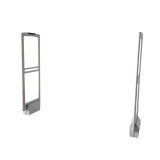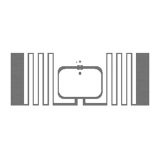Radio-frequency identification (RFID) technology is transforming business operations by simplifying asset tracking and management through the use of electromagnetic fields to automatically identify and track tagged objects. This technology plays a crucial role in various industries, enhancing inventory management, asset tracking, and supply chain visibility. RFID scanning solutions primarily come in two forms: handheld RFID scanners, which offer mobility and flexibility, and fixed RFID readers, which provide continuous, automated monitoring in designated areas. Both types of scanners are essential for optimizing operational efficiency and accuracy in different business environments.
This article will help businesses decide which option is best for them by looking at the features, benefits, and use cases of both handheld scanners and fixed readers.
Table of Contents
Understanding handheld RFID scanners
Handheld RFID scanners are portable RFID devices designed for manual scanning of RFID tags. These devices allow users to move freely within their operational environment, making them ideal for tasks that require mobility and flexibility. By holding the scanner and directing it toward the items, users can quickly read multiple tags simultaneously without needing a direct line of sight.

Benefits of handheld RFID scanners
Handheld scanners offer several advantages across various business environments:
- Portability and ease of use: Lightweight and ergonomically designed, handheld scanners are easy to carry and operate. This portability ensures that staff can move around efficiently while performing inventory checks or asset tracking.
- Versatility in different settings: Whether in retail stores, warehouses, or field operations, handheld scanners provide the flexibility needed to adapt to different tasks and locations.
- Speed and efficiency: Unlike barcode scanning, which requires each item to be scanned individually, handheld RFID scanners can read multiple tags at once. This significantly speeds up processes such as inventory counts or locating specific assets.
Common use cases
Handheld RFID scanners excel in various scenarios, providing tangible benefits in day-to-day operations:
- Inventory management: Retail stores often use handheld scanners during stock takes to quickly count items on shelves or in the back room. This reduces the time spent on inventory audits and minimizes human error.
- Asset tracking on the go: In industries like construction or utilities, employees frequently move between sites. Handheld scanners enable these workers to track equipment and tools efficiently as they change locations.
- Checking items in and out of storage: Warehouses benefit from the portability of handheld scanners when managing items entering or leaving storage areas. Workers can easily scan goods without being confined to a fixed location.
By leveraging handheld RFID technology, businesses enhance their operational workflows with increased mobility, accuracy, and efficiency.
Exploring fixed RFID readers
Fixed RFID readers are stationary devices designed to read RFID tags continuously. Their primary advantage lies in their ability to provide real-time tracking of assets, making them ideal for environments where constant monitoring is crucial. These readers are typically installed at strategic points within a facility, such as doorways or along conveyor belts, ensuring comprehensive coverage and seamless operation.

Functionality of fixed RFID readers
Fixed readers operate by emitting radio waves that activate RFID tags within their range. Upon activation, the tags send back information to the reader, which then processes and records this data. This continuous scanning capability allows fixed readers to track large volumes of items as they move through different stages of the supply chain.
- Stationary nature: Unlike handheld scanners, fixed readers remain in one place, offering uninterrupted scanning.
- Continuous scanning: They provide a steady stream of data, enabling real-time asset tracking and inventory management.
Benefits in high-volume environments
In high-volume settings like warehouses or production lines, fixed RFID readers significantly enhance operational efficiency. By automating the scanning process, these devices reduce the need for manual labor and minimize errors associated with human intervention.
- Real-Time Tracking: Essential for operations requiring constant oversight, such as monitoring goods on a conveyor belt or tracking entry/exit points in a warehouse.
- Operational Efficiency: Helps streamline processes by providing accurate and up-to-date information on inventory levels and asset locations.
Common installation locations
Fixed RFID readers are strategically placed to maximize their effectiveness:
- Doorways: Ideal for tracking items entering or leaving a facility.
- Conveyor belts: Perfect for monitoring goods as they move through different stages of production or sorting.
- Dock doors: Useful for recording shipments being loaded or unloaded.
By understanding the functionality and benefits of fixed RFID readers, businesses can better assess whether these stationary devices align with their needs for continuous monitoring and operational efficiency.
Key considerations for choosing between handheld RFID scanners and fixed readers
1. Assess your operational needs
Understanding your specific business workflows is crucial when deciding between handheld and fixed RFID solutions. Every business has its own unique requirements that can greatly affect which type of RFID reader is more suitable.
Mobility requirements:
- Handheld RFID scanners: These are ideal for scenarios where mobility is crucial. For instance, if your business involves conducting inventory audits across various store locations, the portability of handheld scanners allows employees to move freely and scan items efficiently. This flexibility is particularly beneficial in retail environments where store layouts frequently change or in field operations where items are dispersed across different areas.
Continuous monitoring needs:
- Fixed RFID readers: These readers excel in environments where continuous monitoring and real-time tracking are essential. In high-volume settings such as warehouses or production lines, fixed readers provide seamless scanning capabilities without manual intervention. They ensure that assets are automatically tracked as they pass through specific points like doorways or conveyor belts, enhancing operational efficiency.
Understanding these operational needs helps businesses determine which RFID technology aligns best with their workflow requirements. Whether you prioritize mobility for dynamic tasks or continuous monitoring for streamlined operations, choosing the right solution can significantly impact your business’s efficiency and productivity.
3. Environmental factors impacting decision-making
Different business environments can significantly influence the effectiveness of either handheld or fixed RFID technology deployment strategies. The key is to understand how your specific setting impacts the utility and efficiency of these systems.
Handheld RFID scanners in dynamic settings
In dynamic settings, such as retail stores that frequently undergo layout changes, handheld scanners offer unparalleled flexibility. These devices allow staff to adapt quickly to new inventory placements or store configurations. For instance, during seasonal shifts when stock locations change, handheld scanners simplify the task of updating inventory records without the need for reconfiguring fixed setups.
Fixed RFID readers in controlled environments
On the other hand, fixed RFID readers shine in controlled environments with stable infrastructure, like warehouses or production lines. Here, continuous monitoring is crucial for maintaining operational efficiency. Fixed readers provide seamless tracking of assets as they move through various checkpoints, such as conveyor belts or loading docks. This real-time data capture ensures that inventory levels are always accurate, reducing manual intervention and potential errors.
Evaluating environmental factors helps in making an informed choice between mobility and continuous monitoring needs. By assessing your business environment’s specific requirements, you can determine whether the adaptability of handheld scanners or the reliability of fixed readers aligns better with your operational workflows.
Conclusion
When selecting the right RFID solution for your business, it’s essential to consider your specific operational needs. Handheld RFID scanners offer the flexibility of mobile scanning, making them ideal for tasks requiring mobility, such as inventory checks and on-the-go asset tracking. In contrast, fixed RFID readers provide continuous, automated coverage that is perfect for high-traffic areas and consistent monitoring. Evaluating these options in the context of your business goals will help you make an informed choice. If you’re looking for a reliable manufacturer, Asecuri’s handheld RFID scanners provide dependable performance and advanced features to meet the demands of various industries. Choose Asecuri for your RFID needs and ensure your business stays efficient and competitive.


































